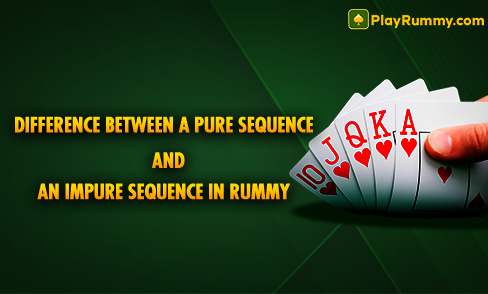Rummy is an online game that stands as a timeless card game cherished by individuals globally for countless years. It seamlessly melds skill, strategy, and a touch of fortune, endearing it to enthusiasts of all ages. In the realm of Rummy, a pivotal element revolves around the creation of sequences, serving as a fundamental cornerstone of the game. These sequences are typically classified into two primary categories: pure rummy sequence and impure sequence. This piece aims to explore the key differences between these two sequence varieties and illuminate their importance in the realm of Rummy.
Pure Sequence
When you play online rummy, a pure sequence in this card game is a group of consecutive cards of the same suit. To be considered a pure sequence, it must consist of at least three cards. For example, if you have the 5, 6, and 7 of hearts in your hand, you’ve formed a rummy pure sequence. Pure sequences are vital in Rummy because they are the foundation for declaring the game. You cannot declare Rummy without a pure sequence.
Here is a rummy sequence list to remember:
Same Suit: As mentioned earlier, a pure sequence should consist of cards from the same suit. This means you cannot use cards from different suits to form a pure sequence.
Consecutive Cards: The cards in a pure sequence should be in consecutive order, such as 4, 5, 6 or 9, 10, J (Jack).
Minimum Length: A pure sequence should have a minimum of three cards. It can be longer, but three is the minimum requirement.
Essential for Declaration: If you intend to declare the online game, you must have at least one pure sequence in your hand. Without it, your declaration is invalid.
Impure Sequence
An impure sequence, on the other hand, also consists of consecutive cards but can include one or more cards from different suits, often referred to as “jokers.” Impure sequences are an essential part of a successful Rummy strategy as they allow you to use wild cards or jokers to complete sequences more easily.
Here are some key points to remember about impure sequences:
Mixed Suits: Unlike pure sequences, impure sequences can contain cards from different suits. This means you can use jokers to replace missing cards from the same suit.
Wild Cards: Jokers or wild cards can be used in impure sequences to represent any missing card in the sequence. For instance, if you have 4 of spades, a joker, and 6 of spades, you’ve formed an impure sequence. The joker stands in for the missing 5 of spades.
No Minimum Length: There’s no minimum length requirement for impure sequences. You can have an impure sequence with just two cards, as long as it contains a joker.
Not Necessary for Declaration: While pure sequences are essential for declaring Rummy, impure sequences are not. However, they are incredibly useful for managing your hand and completing sets.
Differences and Importance
When you download rummy app & start playing, you’ll notice that the primary difference between pure and impure sequences lies in their composition. Pure sequences are made up of consecutive cards from the same suit and are indispensable for declaring Rummy, while impure sequences can contain mixed suits and are often used to incorporate jokers or wild cards. To make things clearer, let’s discuss the importance of each type of sequence in the game of Rummy.
Importance of a Rummy Pure Sequence:
Foundation for Declaration: Pure sequences are the foundation for declaring Rummy. Without a pure sequence, your hand is invalid for declaring, regardless of the number of sets you have.
Strategic Value: Building pure sequences early in the game is strategic because it gives you the opportunity to declare your hand quickly when the right cards come your way.
Risk Reduction: Having a pure sequence can reduce the risk of losing more points if your opponent declares the online game. You’ll only lose points based on the cards left in your hand.
Importance of Impure Sequences:
Flexibility: Impure sequences provide flexibility in forming sets and sequences, allowing you to adapt to the cards you’re dealt.
Joker Utilization: Jokers or wild cards can be optimally used in impure sequences to fill gaps in your sets and sequences, making it easier to declare Rummy.
Managing Unwanted Cards: Impure sequences are a great way to utilize cards that don’t fit into your pure sequences, helping you reduce your overall point count.
In conclusion, understanding the difference between pure sequences and impure sequences is fundamental to becoming a skilled Rummy player. Pure sequences are the backbone of declaring Rummy, and you must have at least one in your hand to declare the card game. On the other hand, impure sequences offer flexibility, help you manage unwanted cards, and make it easier to complete sets and sequences. Both types of sequences have their unique importance in the game, and a successful Rummy player knows how to balance and utilize them effectively to secure a victory. So, the next time you play Rummy, keep these distinctions in mind to enhance your gameplay.









